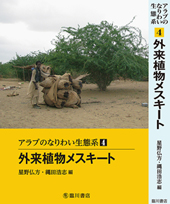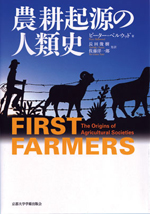Publications
RIHN Library
RIHN has published academic books dealing with the research activities of the RIHN staff.

Arab Subsistence Ecosystem Series Vol. 4
『The Alien Species Mesquite』
Mesquite (Prosopis juliflora) was considered an ideal anti-desertification tree in West Asia and Africa due to its high capacity to stabilize sand dunes, survive in inhospitable environments, and provide fuel, timber, fodder, and edible pods. Once planted, however, the mesquite seedlings failed to take root on sand dunes, but rather became well established in oases, where they contributed to the lowering of the water table and suppression of native vegetation. The invasion of mesquite not only changed the regional ecosystem, but has also caused livelihood degradation of local communities. The authors seek to learn from the unintended consequences of the joint action of scientists, administrators, and NGO workers, to go beyond criticism, and to continue doing high quality and appropriate scientific research. Scientists from universities, research institutions, NGO members, consulting firms, developmental organizations, and local people must work together, pooling their best knowledge to build an effective mesquite management plan.
- Edited by HOSHINO Buho, NAWATA Hiroshi
- Language: Japanese
- Published by RINSEN BOOK CO., December, 2013
- 3,600 yen (tax included)
- ISBN 978-4-653-04214-3 C0322
- Publisher's Website

Arab Subsistence Ecosystem Series Vol. 3
『Mangroves』
This book clarifies the history, botanical characteristics, and human uses of dryland mangroves. It focuses on description of the gray mangrove (Avicennia marina) from the viewpoints of paleontology, plants physiological ecology, social ecology, analysis by remote sensing, cultural anthropology, history, and mangrove plantation studies. Its purpose is to improve understanding, conservation, and wise use of dryland mangroves and so to recover and improve this foundation of coastal life in arid lands.
- Edited by NAKAMURA Ryo, NAWATA Hiroshi
- Language: Japanese
- Published by RINSEN BOOK CO., December, 2013
- 3,600 yen (tax included)
- ISBN 978-4-653-04213-6 C0322
- Publisher's Website

Arab Subsistence Ecosystem Series Vol. 2
『Date Palms』
This book describes the deserts, oases and patterns of human subsistence in the arid lands of Africa, focusing especially on the historical, geographical, botanical, and anthropological aspects of the important species of date palm, Phoenix dactylifera. Humankind has interacted with date palm for more than 5000 years, and this experience has been an important source of indigenous knowledge and social relations—such as water conservation and communal sharing—enabling survival in arid lands. The date palm is not just an important source of food, but also a keystone species providing shade which creates micro climate conditions for cropping in very dry and hot environments. The date palm culture remains important today even despite the transformation of Arab societies under modernization.
- Edited by ISHIYAMA Shun, NAWATA Hiroshi
- Language: Japanese
- Published by RINSEN BOOK CO., December, 2013
- 3,600 yen (tax included)
- ISBN 978-4-653-04212-9 C0322
- Publisher's Website

Dying words: Endangered languages and what they have to tell us.
The next century will see more than half of the world's 6,000 languages become extinct, and most of these will disappear without being adequately recorded. Written by one of the leading figures in language documentation, this fascinating book explores what humanity stands to lose as a result.
- Written by Nicholas Evans
- Translated by Masayuki Onishi, Toshiki Osada and Wakaba Mori
- Language: Japanese
- Published by Kyoto University Press, 2013
- 5,460 yen (tax included)
- ISBN 9784876982097
- Publisher's Website

Dryland Mangroves: Frontier Research and Conservation, Arab Subsistence Monograph Series Volume 2
Japanese researchers and development NGOs have been particularly active in the research and conservation of dryland mangroves in the Gulf and Red Sea areas. This book compiles academic results and practical know-how of such activities, in which local administrators and people have also been involved. Descriptions and conservation techniques are given in both Arabic and English with an optimum number of photos and figures in order to serve the practical needs of those in charge of conservation and reforestation.
- Edited by Hiroshi Nawata
- Language: Arabic and English
- Published by Shoukadoh Book Sellers, 2013
- 4,200 yen (tax included)
- ISBN 978-4-87974-670-2 C3039
- Publisher's Website

Exploitation and Conservation of Middle East Tree Resources in the Oil Era, Arab Subsistence Monograph Series Volume 1
How have Middle East tree resources been exploited and conserved in the pre-oil and oil eras? This book describes three site- and context-specific case studies: a nature reserve management system in a juniper woodlands in Saudi Arabia; an evaluation of fuel wood consumption with improved cooking stoves in Chad; and resource use in mangrove forests along the Swahili coast in Tanzania. The volume is printed in English, Arabic, French and Kiswahili so that we can share information with the international scientific community as well as local people.
- Written by Hiroshi Nawata, Shun Ishiyama, and Ryo Nakamura
- Language: Arabic, English, French and Swahili
- Published by Shoukadoh Book Sellers, 2013
- 5,800 yen (tax included)
- ISBN 978-4-87974-672-6 C3036
- Publisher's Website

Current Studies on the Indus Civilization Volume 4, 5, 6, 7, 8, 9
- Language: English
- Published by Manohar Publishers & Distributors, 2011 & 2012, India
- Volume 4: ISBN 9788173049101 Edited by OSADA Toshiki & UESUGI Akinori
- Volume 5: ISBN 9788173049118 Edited by OSADA Toshiki & UESUGI Akinori
- Volume 6: ISBN 9788173049125 Edited by OSADA Toshiki & UESUGI Akinori
- Volume 7: ISBN 9788173049293 Edited by OSADA Toshiki & UESUGI Akinori
- Volume 8 Part 1 & 2: ISBN 9788173049309 Written by Randall William Law
- Volume 9: ISBN 9788173049484 Edited by OSADA Toshiki & ENDO Hitoshi
- Publisher's Website

Yakihata no Kankyo-Gaku (Environmental Study of Swidden Agriculture)
- Supervised by SATO Yo-ichiro
- Edited by Harada Nobuo & KURATA Takashi
- Language: Japanese
- Published by Shibunkaku, 2011
- 9,450 yen (tax included)
- ISBN 978-4-7842-1588-1
- Publisher's Website (Japanese)

Current Studies on the Indus Civilization Volume 1, 2, 3
- Edited by OSADA Toshiki & UESUGI Akinori
- Language: English
- Published by Manohar Publishers & Distributors, 2010, India
- Volume 1: ISBN 9788173048623
- Volume 2: ISBN 9788173048609
- Volume 3: ISBN 9788173048616
- Publisher's Website

urasia Noukoushi 5 (Agricultural History in Eurasia 5)
- Supervised by SATO Yo-ichiro
Edited by KURATA Takashi - Language: Japanese
- Published by Rinsen Book, 2010
- 2,940 yen (tax included)
- ISBN 978-4-653-04045-3
- Publisher's Website (Japanese)

Eurasia Noukoushi 4 (Agricultural History in Eurasia 4)
- Supervised by SATO Yo-ichiro
- Edited by KIMURA Emi
- Language: Japanese
- Published by Rinsen Book, 2009
- 3,150 yen (tax included)
- ISBN 978-4-6530-4044-6
- Publisher's Website (Japanese)

Linguistics, Archaeology and Human Past in South Asia
This book contains a selection of papers presented at the 7thHarvard Roundtable on Ethnogenesis of South and Central Asia co-organized by the Department of Sanskrit and Indian Studies, Harvard University and Research Institute for Humanity and Nature (RIHN), Kyoto, Japan. (This text is extracted from the summary written on the book cover)
- Edited by OSADA Toshiki
- Language: English
- Published by Manohar Publishers & Distributors, 2009, India
- ISBN 978-81-7304-799-2
- Publisher's Website

Indus Civilization: Text and Context. VOLUME II
This volume is the second publication of the Indus Project, at the Research Institute for Humanity and Nature (RIHN) in Kyoto, Japan. It consists of four papers and two appendices.
The work is in two parts. The first two papers deal with Indus Script and the remaining papers are reports of the first season's excavations at Kanmar and Kachchh, Gujarat. In the appendices the Harrappan sites od Gujarat and the excavated sites in the Greater Indus Valley are listed. (This text is extracted from the summary written on the book cover)
- Edited by OSADA Toshiki
- Language: English
- Published by Manohar Publishers & Distributors, 2009, India
- ISBN 978-81-7304-821-0
- Publisher's Website

Eurasia Noukoushi 3 (Agricultural History in Eurasia 3)
- Supervised by SATO Yo-ichiro
- Edited by KURATA Takashi
- Language: Japanese
- Published by Risnsen Book, 2009
- 2,940 yen (tax included)
- ISBN 978-4-6530-4043-9
- Publisher's Website (Japanese)

Eurasia Noukoushi 2 (Agricultural History in Eurasia 2)
- Supervised by SATO Yo-ichiro
- Edited by KIMURA Emi
- Language: Japanese
- Published by Rinsen Book, 2009
- 2,940 yen (tax included)
- ISBN 978-4-6530-4042-2
- Publisher's Website (Japanese)

Eurasia Noukoushi 1 (Agricultural History in Eurasia 1)
- Supervised by SATO Yo-ichiro
- Edited by KURATA Takashi
- Language: Japanese
- Published by Rinsen Book, 2009
- 2,940 yen (tax included)
- ISBN 978-4-6530-4041-5
- Publisher's Website (Japanese)

Noko Kigen no Jinruishi (Japanese Title)
First Farmers: The Origins of Agricultural Societies (English Title)
- Written by Bellwood, PETER
- Translated by Osada Toshiki and SATO Yo-ichiro
- Language: Japanese
- Published by Kyoto University Press, 2008
- 5,460 yen (tax included)
- ISBN 978-4-8769-8722-1
- Publisher's Website

Himaraya to Chikyu Ondanka (The Himalayas and Global Warming)
- NAKAWO Masayoshi
- Language: Japanese
- Published by Showado, 2007
- 2,415 yen (tax included)
- ISBN 978-4-8122-0721-5
- Publisher's Website (Japanese)

Hito wa Naze Hana o Mederu noka (Why Do People Love Flowers?)
- Edited by SHIRAHATA Yozaburo
- Language: Japanese
- Published by Yasaka Shobo, 2007
- 2,520 yen (tax included)
- ISBN 978-4-8969-4890-5
- Publisher's Website (Japanese)

Indus Civilization: Text and Context
This volume is the first publication of the Indus Project, at the Research Institute for Humanity and Nature (RIHN) in Kyoto, Japan. The work consists of three papers and a comprehensive bibliography. In the first paper Kharakwal presents an overview of Indus civilization with the most recent data in a compact way. Witzel's paper, which is the longest, deals with the ancient connection with South Asia and Central Asia Illustrated by the analysis of Vedic texts. In the last paper Sato suggests a key role for rice in the ancient Indus area. The bibliography on Indus civilization compiled by Osada covers latest material on the Indus script, seals, raw materials and network with Mesopotamia. (This text is extracted from the summary written on the book cover)
- Edited by OSADA Toshiki
- Language: English
- Published by Manohar Publishers & Distributors, 2006, India
- ISBN 978-8-1730-4682-7
- Publisher's Website

Sekai Isan o Shika ga Kuu (Deer Eats the World's Heritage)
- Edited by YUMOTO Takakazu and MATSUDA Hiroyuki
- Language: Japanese
- Published by Bunichi Sogo Shuppan, 2006
- 2,520 yen (tax included)
- ISBN 978-4-8299-1190-7
- Publisher's Website (Japanese)

Kusunoki to Nihonjin (Camphor Trees and the Japanese)
- Written by SATO Yo-Ichiro
- Language: Japanese
- Published by Yasaka-Shobo, 2004
- 2,730 yen (tax included)
- ISBN 978-4-8969-4848-6
- Publisher's Website (Japanese)
▲PAGE TOP

